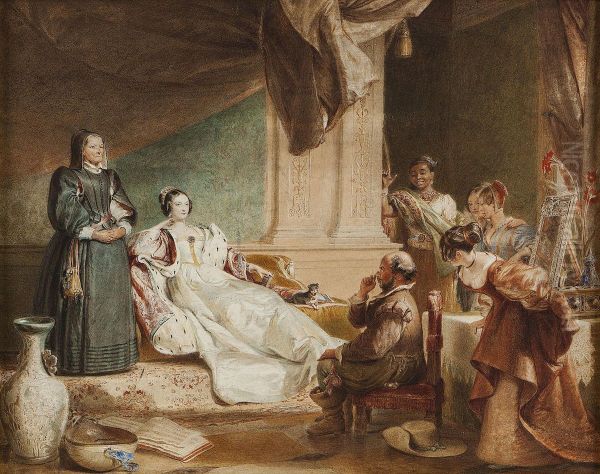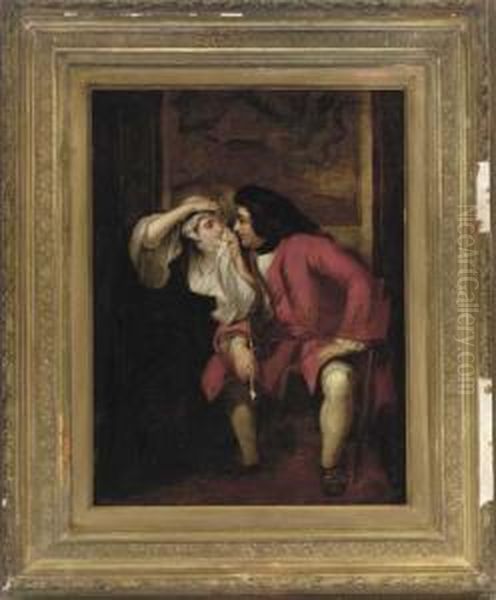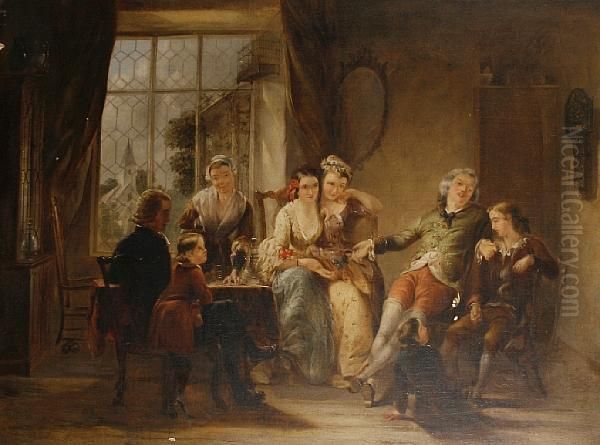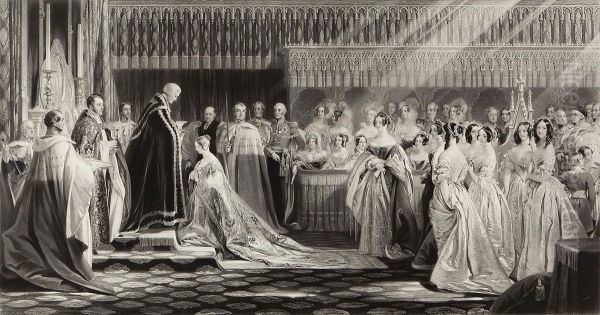
Charles Robert Leslie stands as a significant figure in the landscape of 19th-century British art. Born in London to American parents on October 19, 1794, his life and career bridged the Atlantic, blending influences from both his native and ancestral lands. Primarily celebrated for his genre paintings drawn from literature and history, Leslie was also a respected portraitist, a dedicated educator, and an insightful writer whose biographical work on his friend John Constable remains indispensable. His art, characterized by gentle humour, narrative clarity, and a refined sensibility, captured the tastes of his time and secured him a lasting place within the Royal Academy and the broader story of British painting.
Early Life and Artistic Formation
Though born in Clerkenwell, London, Leslie's formative years were spent in Philadelphia, where his parents returned when he was five years old. His father, Robert Leslie, was a respected clockmaker. Following his father's death, young Charles was apprenticed to the bookselling firm of Bradford and Inskeep. It was during this period, surrounded by books and prints, that his innate passion for drawing and a burgeoning interest in the theatre began to truly flourish. His talent was evident early on, and a particularly skillful sketch he made of the actor George Frederick Cooke caught the attention of his employers and other patrons.
Recognizing his potential, funds were raised to enable Leslie to return to London in 1811 to pursue formal art training. This marked a pivotal moment, setting him on a path toward professional artistry. London, at this time, was the vibrant centre of the British art world, dominated by the Royal Academy of Arts. Leslie enrolled as a student at the Academy's schools, immersing himself in the study of anatomy, perspective, and the old masters.

His time at the Royal Academy was fruitful. He studied initially under the guidance of the American-born President of the Royal Academy, Benjamin West, and formed a close friendship with another American artist studying in London, Washington Allston. These connections provided both instruction and camaraderie. Leslie quickly proved his abilities, winning two silver medals during his studentship, signalling his promise to the established art community. He absorbed the academic traditions but soon began carving out his own niche.
Developing a Literary Niche
Leslie's early artistic inclinations leaned towards the grand historical subjects favoured by West, as seen in his initial exhibit at the Royal Academy, Saul and the Witch of Endor. However, his true affinity lay elsewhere. Influenced perhaps by his time in the bookstore and his love for theatre, Leslie found his most authentic voice in depicting scenes from literature and history, often imbued with a gentle humour and keen observation of human character.
He turned to the rich tapestry of British and European literature for inspiration. William Shakespeare, Miguel de Cervantes, Molière, Laurence Sterne, Oliver Goldsmith, and Sir Walter Scott became his muses. Unlike the dramatic intensity sought by some history painters, Leslie excelled in capturing moments of quiet comedy, social interaction, or poignant reflection drawn from beloved texts. His approach was less about high drama and more about narrative charm and character study.
His breakthrough came with Sir Roger de Coverley going to Church (1819), based on characters from Addison and Steele's The Spectator. This work, admired for its gentle humour and careful delineation of character and period detail, established the direction his art would predominantly take. It showcased his ability to translate the nuances of prose into visual form, capturing the spirit and atmosphere of the source material.
Masterpieces of Narrative Painting
Throughout the 1820s and 1830s, Leslie produced a series of highly popular paintings that cemented his reputation. One of his most celebrated works is Sancho Panza in the Apartment of the Duchess (1823), depicting a scene from Cervantes' Don Quixote. The painting captures the earthy Sancho, slightly bewildered but enjoying the attention, amidst the refined amusement of the Duchess and her attendants. Leslie's skill in rendering expressions, textures, and the interplay between characters is fully evident. The work was lauded for its humour and its faithful yet imaginative interpretation of Cervantes.

Another iconic work drew from Laurence Sterne's Tristram Shandy: Uncle Toby and the Widow Wadman (1831). This painting delicately portrays the moment the Widow Wadman attempts to gauge the extent of Uncle Toby's war wound by gazing intently into his eye. Leslie masterfully conveys the mixture of innocence, sentiment, and subtle comedy inherent in Sterne's writing. The careful rendering of the figures, their expressions, and the domestic setting exemplifies Leslie's mature style.
Shakespeare provided a recurring source of inspiration. The Merry Wives of Windsor offered scenes ripe for Leslie's talent, allowing him to explore comedic situations and character interactions. He also depicted scenes from Henry VIII and other plays. Similarly, Molière's comedies and Goldsmith's The Vicar of Wakefield furnished subjects that aligned perfectly with his artistic temperament. His illustrations for the Waverley novels of Sir Walter Scott, such as scenes from The Heart of Midlothian featuring Effie Deans, were also highly regarded.
Style and Technique
Leslie's style is characterized by its clarity, refinement, and attention to detail. He possessed a keen eye for historical accuracy in costume and setting, lending an air of authenticity to his literary and historical scenes. This meticulousness, however, was generally balanced by a warmth and humanity in his portrayal of figures. His drawing was precise, and his compositions were carefully arranged to enhance the narrative.
His handling of paint was typically smooth and controlled, allowing for fine detail without sacrificing overall harmony. His colour palettes were often rich but restrained, contributing to the gentle and agreeable mood of many of his works. He particularly excelled in depicting textures – the sheen of silk, the roughness of wool, the gleam of polished wood – adding a tactile quality to his paintings.
While primarily known for narrative subjects, Leslie was also an accomplished portraitist. He painted likenesses of friends, fellow artists, and literary figures. His portraits often share the same sensitivity and clarity found in his genre works, capturing not just the physical appearance but also something of the sitter's personality.
Compared to the dramatic intensity of some contemporaries or the sublime landscapes of J.M.W. Turner, Leslie's art offered a different kind of appeal – one rooted in narrative charm, gentle wit, and relatable human emotion. His work found favour with patrons who appreciated literary subjects rendered with skill and decorum. He can be seen alongside artists like David Wilkie and William Mulready as a key figure in the development of British genre painting, though Leslie's focus remained more consistently on literary sources.
The Royal Academician and Educator

Leslie's success led to formal recognition from the art establishment. He was elected an Associate of the Royal Academy (ARA) in 1821, a significant step in his career. Full membership as a Royal Academician (RA) followed just five years later, in 1826. This honour solidified his position within the highest ranks of the British art world.
His connection with the Royal Academy extended beyond exhibiting his works. From 1848 to 1852, Leslie served as Professor of Painting at the Academy. In this role, he delivered lectures to students, sharing his insights on art history, technique, and the principles of painting. These lectures formed the basis of his publication, A Handbook for Young Painters (1855), a work valued for its practical advice and thoughtful reflections on the art form.
His teaching and writings reveal a deep engagement with the history and practice of painting. He admired the Dutch masters for their depiction of everyday life and the Venetian school for their colour, but his core principles remained rooted in clear storytelling and careful observation. His Handbook provided guidance that was both accessible and grounded in academic tradition, influencing a generation of younger artists.
A Brief American Interlude
Despite his success in Britain, Leslie briefly returned to the United States in 1833. He accepted a position as Teacher of Drawing at the Military Academy at West Point, New York. This move might have been prompted by family connections or a desire to reconnect with the land of his parents. However, the environment at West Point proved uncongenial to him.
The structured, military atmosphere was perhaps ill-suited to his artistic temperament, and he found himself missing the vibrant artistic community and cultural life of London. After only a few months, he resigned from the post and returned to England in 1834, where he would remain for the rest of his life. This brief interlude highlights the transatlantic nature of his identity but ultimately confirmed that his artistic home was in London.
Friendships and Connections: Constable and Turner
Leslie cultivated important friendships within the London art scene, most notably with the landscape painters John Constable and J.M.W. Turner. His relationship with Constable was particularly close and enduring. They shared a mutual respect and provided each other with support and encouragement in a sometimes critical art world.

Leslie's deep affection and admiration for Constable are most evident in his biographical work, Memoirs of the Life of John Constable, R.A., published in 1843 (with an expanded edition in 1845). Compiled largely from Constable's own letters and conversations, the Memoirs offer an intimate and invaluable portrait of the landscape painter's life, struggles, and artistic philosophy. It remains a primary source for understanding Constable. While some critics have noted that Leslie's loyalty might have led him to present a somewhat idealized image of his friend, omitting certain complexities of Constable's character, the book is undeniably a work of profound friendship and art historical significance. Leslie's account of finding Constable's studio filled with unsold masterpieces after his death in 1837 is a poignant testament to their bond and the challenges Constable faced.
His relationship with J.M.W. Turner was perhaps less intimate but still marked by professional respect and interaction. Leslie recorded anecdotes about Turner in his own Autobiographical Recollections. They were fellow Academicians, and records show interactions such as Leslie negotiating with Turner regarding the painting Staffa, Fingal's Cave and discussing the potential for commercial engravings of Turner's famous work, The Fighting Temeraire. Though their artistic styles differed greatly – Leslie's narrative precision contrasting with Turner's atmospheric Romanticism – they were part of the same institutional fabric at the Royal Academy. Leslie's writings provide valuable glimpses into the personality and working methods of the often-reclusive Turner.
Beyond these key figures, Leslie moved within a circle that included other prominent artists and writers of the day. His connections with figures like Washington Irving (whose portrait he painted and whose works sometimes inspired him) further underscore his position at the intersection of art and literature. His engagement with contemporaries like David Wilkie, whose genre scenes shared some common ground with Leslie's, also places his work within the broader context of early 19th-century British art.
Writings: Memoirs and Handbooks
Leslie's contributions were not limited to the canvas. He was a gifted writer, and his publications provide lasting insights into the art world of his time. His Memoirs of the Life of John Constable stands as his most significant literary achievement, a cornerstone of Constable scholarship. Its detailed account, drawn from primary sources, shaped the perception of Constable for generations.
His Handbook for Young Painters (1855), based on his RA lectures, offered practical instruction blended with aesthetic commentary. It covered aspects of composition, colour, and technique, drawing examples from across art history. The book reflects Leslie's own thoughtful approach to art-making and his commitment to education.

Leslie also penned Autobiographical Recollections, edited and published posthumously by Tom Taylor in 1860. This work provides valuable information about his own life, his artistic development, his experiences in London and America, and his interactions with famous contemporaries like Constable, Turner, Samuel Taylor Coleridge, Washington Irving, and others. It offers personal anecdotes and reflections that enrich our understanding of the cultural milieu in which he operated. His writings, like his paintings, are characterized by clarity, intelligence, and a gentle, observant tone.
Later Life and Artistic Family
In his later years, Leslie continued to paint and exhibit, though perhaps less prolifically than in his prime. He remained a respected figure in the London art world. His work continued to be appreciated for its refinement and narrative charm, even as new artistic trends began to emerge in the mid-Victorian era, such as the Pre-Raphaelite Brotherhood with artists like Dante Gabriel Rossetti and John Everett Millais, who pursued a different kind of detailed realism and intensity.
Leslie's artistic legacy extended to his own family. His son, George Dunlop Leslie (1835-1921), followed in his father's footsteps and became a successful painter and Royal Academician himself. G.D. Leslie specialized in charming scenes of English life and history, often featuring elegant young women in gardens or domestic interiors, echoing his father's refined aesthetic but adapted to later Victorian tastes. Another son, Robert C. Leslie, also became an artist and writer.
Charles Robert Leslie passed away in St John's Wood, London, on May 5, 1859. He left behind a substantial body of work and a reputation as a skillful painter, an influential teacher, and an important chronicler of his artistic times.
Legacy and Evaluation
Charles Robert Leslie occupies a distinct and respected place in British art history. He was a master of the literary genre painting, skillfully translating scenes from beloved authors into visual narratives that charmed and engaged his audience. His work is noted for its technical refinement, careful composition, accurate historical detail, and sensitive portrayal of character and emotion, often infused with gentle humour.
His paintings, such as Sancho Panza in the Apartment of the Duchess and Uncle Toby and the Widow Wadman, remain iconic examples of 19th-century British narrative art. While occasionally criticized by some later commentators for a perceived lack of dramatic force or for an over-reliance on detail, his work consistently found favour during his lifetime and continues to be appreciated for its craftsmanship and literary sensibility. His depictions of women, in particular, are often noted for their grace and delicacy.
Beyond his paintings, Leslie's legacy is significantly enhanced by his writings. His Memoirs of the Life of John Constable is an indispensable biographical work that profoundly shaped the understanding and appreciation of the great landscape painter. His Handbook for Young Painters and Autobiographical Recollections further contribute to our knowledge of 19th-century art practice and the cultural life of the period.
Leslie successfully navigated the transatlantic currents of his time, bringing an American perspective to the London art scene while becoming a quintessential interpreter of British literary and historical themes. He was a central figure at the Royal Academy, both as an exhibitor and an educator. His influence can be seen not only in the work of his son, G.D. Leslie, but also in the broader tradition of narrative painting that flourished in the Victorian era, exemplified by artists like William Powell Frith.
Today, Leslie's works are held in major collections, including the Tate Britain, the Victoria and Albert Museum (which absorbed the South Kensington Museum holdings), the Royal Academy of Arts in London, and various galleries in the UK and the United States. He is remembered as a talented and versatile artist who made significant contributions as a painter, writer, and educator, leaving a rich legacy that continues to inform our understanding of 19th-century British art and culture. His ability to weave together literature, history, and art with sensitivity and skill ensures his enduring importance.